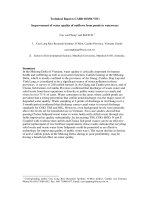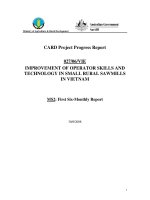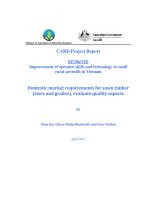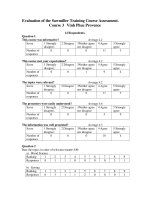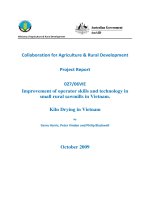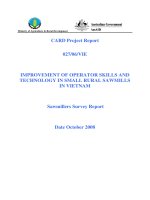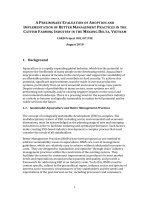Báo cáo khoa học nông nghiệp " Implementation of the IPM program using weaver ants as a major component for cashew growers in Vietnam " pptx
Bạn đang xem bản rút gọn của tài liệu. Xem và tải ngay bản đầy đủ của tài liệu tại đây (68.78 KB, 10 trang )
GAP Workshop in Binh Thuan (21-22/7/2008)
1
Implementation of the IPM program using weaver ants as a major
component for cashew growers in
Vietnam
(Progress activities)
Keith Christian
1
, Renkang Peng
1
and La Pham Lan
2
1
Charles Darwin University
2
Institute of Agricultural Science for South Vietnam
Introduction
Cashew (Anacardium occidentale) is an important crop in Vietnam, and the government
has designated cashew development as a national priority. The area growing cashew is
about 430000 ha located in Central Highlands, South Central Coast and South East region.
Cashew is planted mainly in inverse soils that are low in fertility and with low
precipitation. For years, cashew plants were considered as a forestry plant so that the
growers did not consider any intensive techniques such as fertilization or plant protection
(David 1999). When the decree of Primer Minister signed in 7 May 1999 on the
development of cashew production was released, the growing area of this plant for exports
expanded rapidly in Southern Vietnam. However, the productivity of cashew is low
because of serious damage from insect pests and inadequate farm management. Insect
pests of cashew plants has identified that lepidopterans and hemipterans are predominant
(An 2003, Lan et al. 2002). Generally the use of insecticides is a common practice by
farmers to control insect pests. In some cases the efficacy of insecticides was not proven
due to misuse and farmer use of insecticides as a preventive tool. To achieve high yields
most growers rely heavily on insecticides, resulting in increased costs, pest resistance,
environmental pollution and the reduction of natural enemies and pollinators. The
suggestion of using a biological agent as weaver ant (Oecophylla smaragdina) instead of
insecticides is not new but has potential as a control measure. In the Mekong Delta the
application of weaver ants can control insect pests in citrus orchards and also give fruit
with few blemishes. The use of weaver ants as a biological control agent of insect pests is
common in the Mekong Delta (Barzman et al. 1999). Scientists from Charles Darwin
University found that an IPM program that used weaver ants as a key element had been
successfully used by cashew growers in Australia, Papua New Guinea and Mozambique
(Peng and Duncan, 1999; Peng, 2000, 2001, 2002; Peng, et al., 1999, 2004).
Based on the successful examples on citrus orchards in the Mekong Delta (Vietnam) and
on cashew orchards in Australia and Africa, this project was proposed with the aim of
increasing cashew yield and improving nut quality. Specific objectives are (1) to conduct
TOT training in cashew IPM for TOT trainers to conduct FFSs in their local region, (2) to
develop an IPM cashew curriculum and a series of illustrative posters based on the cashew
IPM programs developed in Australia that will work in Vietnamese conditions and (3) to
assess the effectiveness of the FFS model in increasing farmer knowledge and reducing
pesticide use in cashew production.
Materials and Methods
A Start up workshop was held on 5 May 2006 at the Institute of Agricultural Science of
Southern Vietnam (IAS). A total of 38 experts who are involved in Vietnam cashew
production were invited, they came from plant protection departments, research
institutions, universities, non-government organizations, agricultural services and rural
departments, an insecticide company and media corporations.
GAP Workshop in Binh Thuan (21-22/7/2008)
2
Selection study sites: Six provinces included Binh Phuoc, Dong Nai, Binh Duong, Binh
Thuan, Ba Ria Vung Tau and Dak Lak as the target provinces for this project.
A Base line survey was conducted in Binh Phuoc, Dong Nai, Binh Duong, Binh Thuan, Ba
Ria Vung Tau and Dak Lak provinces.
Organization of Training of Trainees (TOT) classes: Two TOT courses were organized.
One TOT was held at the sub-PPD of Binh Phuoc province, and the other at the Hung Loc
Agricultural Research Center belonging to IAS located in Dong Nai province. Two TOT
courses have resulted in 60 trainees (30 each), who are currently IPM trainers in rice and
vegetables in provincial sub-PPD. Because cashew trees are perennial, the period from
flowering to harvesting is more important than other periods. The TOT courses ran from
flowering to harvest. At each site, one demonstration cashew orchard was established to
enable trainees to practice. Each demonstration orchard is 1.2 ha, divided into two
treatments. One treatment was managed by the orchard owner with his current farming
practices including insecticide sprays. The other was managed by the IPM program. The
two TOTs of 1
st
year have been completed, the two TOT of the 2
nd
year are currently
running. A total of 120 cashew IPM trainers will be available at the end of the project.
Organization of Farmer Field School (FFS) classes: After finishing the course 60 TOT
trainees will become cashew IPM trainers. The 60 IPM trainers will be divided to 30
groups (2 for each group), and each group will run one FFS. Each FFS will take 25
farmers. A total of 30 FFSs will be completed in the 1
st
year and a total of 750 cashew
smallholders will be trained in cashew IPM. In the 3
rd
year, each group of “old trainees” (2
trainers) will run 2 FFSs, and each group of “new trainees” (2 each) will run one FFSs,
Results and Discussion
Start–up Workshop
Thirty-eight experts who are involved in Vietnam cashew production were invited, and
they came from plant protection departments, research institutions, universities, non-
government organizations, agricultural services and rural departments, an insecticide
company and media corporations. The main results from this workshop are summarised
below.
1. All participants expressed their interest in having the cashew IPM project for Vietnam
cashew small holders, and they said “this is the right time to implement this project for
cashew smallholders because of (1) the cashew nut price decreased by 35% in 2006,
and farmers obtained very little profit due to the high cost of insecticides, fungicides
and fertilizers, (2) some farmers are planning to cut cashew trees for growing rubber
trees due to the current high rubber price and (3) many cashew smallholders are
considering whether they will continue to grow cashews or change to rubber.”.
2. The participants all agreed with the project objectives, expected outputs and approach
and methodology.
3. They made some useful comments and suggestions on the draft training program based
on problems they identified in the current cashew production and farmers’
requirements. The draft training program was revised and finalised accordingly.
GAP Workshop in Binh Thuan (21-22/7/2008)
3
Baseline survey
1. Farmers’ opinion towards the cashew IPM program using weaver ants as a major
component
The baseline survey was conducted by TOT trainees in their own provinces using a
standard questionnaire; so that the TOT trainees were aware of the major problems cashew
smallholders have in cashew production and what problems the farmers think need to be
resolved. A total of 212 cashew farmers in 8 major cashew growing provinces (Binh
Phuoc, Dak Lak, Dak Nong, Binh Duong, Ninh Thuan, Dong Nai, Binh Thuan, Ba Ria -
Vung Tau) were interviewed, and 206 farmers expressed their interest in this program and
were keen to participate in the FFS training. Of the 6 farmers that did not want to
participate in the FFS training, one wanted to switch from cashew to rubber due to the
current higher rubber price, one did not want to use weaver ants, and 4 could not afford the
time for the FFS but they would use the IPM program in their orchards if the IPM project
was successful. The main goals of those farmers who were willing to have the FFS training
were (i) to increase yield using integrated methods of pest control and farming strategies,
(ii) to improve the farm environment through reduction of insecticide use, and (iii) to get
more experience in cashew cultivation.
This result shows that our cashew IPM project meets the cashew farmers’ requirements.
2. Current cashew farming status
Based on this baseline survey, the majority of cashew growers were small holders, having
about 2 ha of orchards with the average tree age being 6 years (for grafted materials) and
12 years (for trees produced from seeds) (Table 1). Cashew nut yield was about 1400 kg/ha
in 2005 and 1000 kg/ha in 2006. Cashew apples were generally wasted: only 5% of
farmers used apples either for sale or for their own consumption.
Table 1. Orchard size, tree age and average yield in 2005 and 2006.
Yield (kg/ha)
Tree origin
in orchards
Orchard size
(ha)
Tree age
(years)
2005 2006
No. of
orchards
Graft 1.6 + 1.6 6.1 + 2.9 1388 + 602 1062 + 516 46
Seed 2.1 + 1.6 12.1 + 4.4 1500 + 833 1056 + 707 124
Traditionally, cashew growers did not use fertilizers, insecticides or fungicides. Nowadays,
84% of them used fertilizers from 1 to 3 times a year. Among these, most farmers used
chemical fertilizers only, and a few farmers used farm manure. The time fertilizers were
applied and the methods used were mostly appropriate (Table 2).
Table 2. Fertilizer use in small holders’ orchards.
Type of fertilizer No. of orchards No. of times /year Period of use
Chemical fertiliser only 129 1.6 + 0.6 April-May;
September-October
Chemical fertilizer & farm
manure
41 2.0 + 1.3 April-May;
September-October
Farm manure only 4 2.0 +
0.0 April-May;
September-October
GAP Workshop in Binh Thuan (21-22/7/2008)
4
Of the 206 farmers interviewed, 171 (83%) and 116 (56%) used insecticides and fungicides
respectively. The frequency was 2.5 times (ranging from 1 to 6 times) per year for
insecticides, and 2.2 times (ranging from 1 to 4 times) per year for fungicides (Table 3).
The period of applying insecticides and/or fungicides was based on the information
obtained from Farmers’ clubs, Farmers’ organizations or neighbours, rather than from their
own orchard monitoring.
Table 3. Pesticide use in small holders’ orchards
Type No. of orchards No. of times /year Period of use
Insecticides 171 2.5 + 1.3 Pre-flowering, flowering + nut setting
Fungicides 116 2.2 + 1.0 Flowering + nut setting
Of 16 farmers who did not use fertilizers but had similar tree age in their orchards, 6 of
them who used insecticides once a year did not get higher yield than the other 10 who did
not use insecticides at all (Table 4). This suggests that use of insecticides without
monitoring is not successful.
Table 4. Comparison of cashew nut yields between orchards with insecticide spray and
those without insecticide spray.
Yields
(kg/ha)
Orchards Age Fertilizer Fungicides Insecticides
2005 2006
10 8 - 11 None None None 955 + 422 710 + 690
6 8 - 12 None None Yes
(1 time/year)
927 + 629 583 + 343
For other farming practices, the majority of farmers controlled weeds either by using
herbicides or by physical cutting. Pruning was also practiced by most farmers, but the way
they did it was not appropriate in most orchards. Mulching and irrigation were generally
not practiced.
Costs of insecticides, fungicides and fertilizers are shown in Table 7. For orchards with
grafted materials, costs were VND 383,903, VND 251,475 and VND 1,500,250 for
insecticides, fungicides and chemical fertilizers respectively. For orchards grown from
seeds, costs were VND 367,096, VND 206,722 and VND 1,222,886 for insecticides,
fungicides and chemical fertilizers respectively (Table 5). These data together with yield
data in Table 1 will be used for a comparison between ‘before’ and ‘after’ the cashew IPM
program implementation.
Table 5. Costs of insecticides, fungicides and chemical fertilizers.
Orchard type Insecticide
(VND/ha)
Fungicide
(VND/ha)
Chemical fertilizers
(VND/ha)
Graft 383,903 + 328,709 251,475 + 263,927 1,500,250 + 1,510,312
Seed 367,096 + 454,162 206,722 + 314,562 1,222,886 + 1,109,184
As costs of labour and equipment for application of pesticides and fertilizers greatly
differed among the farmers, the analyses of these categories could not be done.
GAP Workshop in Binh Thuan (21-22/7/2008)
5
3. Farmers’ knowledge of cashew insect pests and diseases and their natural enemies
There were 182 farmers who addressed this issue. For insect pests and diseases, there were
135 farmers (74%) who could recognise only one insect pest or disease, 36 farmers (20%)
who knew two insect pests and diseases and only 11 farmers (6%) who knew more than
two insect pests and diseases.
With regard to the knowledge about natural enemies of cashew insect pests, of the 200
farmers who addressed this issue, 92 (46%) had no knowledge of the natural enemies.
Although 108 (54%) of the farmers put “yes” for the question, most of them only knew one
or two groups of general natural predators such as spiders, ants, ladybirds, preying mantis
or birds. These data clearly show that farmers lack extensive knowledge about the insect
pests and diseases and their natural enemies.
4. Weaver ant status and farmers’ opinion of them
Most orchards had weaver ants, but their populations were very low due to insecticide
application. Most farmers knew weaver ants, and regarded them as beneficial. A total of
200 farmers answered these questions. There were 15 orchards without weaver ants, and
these orchards were sprayed more than three times per year. These owners knew nothing
about the ants. There were 185 orchards with weaver ants, and these orchards were either
not sprayed or sprayed either one or two times a year. The ant populations in most orchards
were very low. These orchard owners had different opinions about the ants: of 185 farmers,
58 (31%) were not sure whether the ants were beneficial or harmful; 29 (15%) were
negative, saying that the ants were harmful because they disturbed harvest or pruning and
they protected mealy bugs; 98 (53%) were positive, claiming that the ants ate insect pests.
These data indicate that extensive and intensive training with the biology of the ant is
crucial, and that the demonstration orchards with established weaver ant colonies will
provide farmers with a full picture of how the ants can benefit them.
Organization of TOT courses
The 1
st
TOT (2006-2007)
The first period of TOT training was started in July 2006 at both Binh Phuoc training
centre and Dong Nai training centre. The final training of the first year TOT training took
place in May 2007 at both Dong Nai and Binh Phuoc training centres. Trainees were very
interested in courses and practicals. They were satisfied with the training methods. The
trainees were fully convinced by the field data collected, by course instructors or by
themselves in field practicals, showing that weaver ants were very effective in controlling
the most important cashew pests of shoot borers and tea mosquito bugs, and the control
levels were acceptable by cashew farmers who participated in this training. Therefore, the
course of training had already built up trainees’ confidence in using weaver ants as a major
component of the cashew IPM program.
At the end of the training, to examine the TOT trainee’s knowledge in cashew IPM and to
get their feedback for each course and the practicals we delivered, we conducted an
examination with 15 practical questions covering all training aspects and a class survey
with questionnaires of 15 courses and the confidence in using cashew IPM methods and in
opening FFSs. The results showed that the trainees expressed ‘satisfactory’ or ‘good’ for
all courses delivered. Five courses: ‘Natural enemies and their conservation’, ‘The effect
of weaver ants on the main cashew insect pests’, ‘The biology of weaver ants’, ‘The IPM
principles’, and ‘Skills of communication and activation in class’ were ranked highest.
None of the courses were ranked at 4 ‘unsatisfactory’ or 5 ‘very unsatisfactory’. In terms
of the confidence in using cashew IPM methods, 54% of the trainees chose “confident”
GAP Workshop in Binh Thuan (21-22/7/2008)
6
and 46% chose “good”. For the confidence in operating FFSs, 8% of them chose “very
confident’, 54% chose “confident” and 38% chose “good”.
In addition to this, some important comments and suggestions from the TOT trainees
included: (i) More practice is needed for each course, (ii) Some topics are overlapped
between courses, (iii) More time is needed for the course of communication skills, and (iv)
The effect of pesticides on human health and the environment should be given in the
course of ‘The use of pesticides in IPM program’.
The 2nd TOT (2007-2008)
The second year TOT training has started in August 2007. There were 56 IPM trainers
from 9 cashew-growing provinces. Due to strong requests from sub-PPDs of Tra Vinh and
Tay Ninh provinces, 4 IPM trainers were selected from these two provinces for this cashew
IPM training. Based on the first year TOT training experience and the comments and
suggestions from the first year TOT graduates, the training courses and training days for
each course for the second year TOT training was modified. The first period of the second
year TOT training was conducted from 20 to 26 August 2007 in Dong Nai training centre
and from 23 to 29 August 2007 in Binh Phuoc training centre. The second year TOT
training is progressing well.
This training concentrated on: weaver ant biology and ecology, how to use weaver ants in
cashew orchards, and the main cashew pests and their natural enemies. In each topic, the
course teacher gave trainees plenty of time to ask questions in the classes and to practice in
cashew orchards. The trainees were fully convinced of the effectiveness of the IPM
program by their own field observations on weaver ant biology and the high control
efficiency of natural enemies on aphis and mealy bugs. The trainees were also satisfied
with our training methods.
During this training period of the 2
nd
TOT course, two extra people were trained. Mr
Nguyen Van Thai – ACCP Officer – and his assistant, from The Asian Pangolin
Conservation Program (APCP), Small Carnivore Conservation Program (SCP), Cuc
Phuong National Park, Ninh Binh. After Mr Thai found weaver ants to be the best food to
rear the endangered pangolins (intercepted from smuggling), they contacted us, wishing to
participate in this weaver ant training in order to establish a weaver ant farm. To assist with
this endangered animal conservation program, we strongly supported their idea and
accepted Mr Thai and his assistant for this weaver ant technology training.
Organization of Farmer Field School
This activity is for the first year TOT graduates to conduct FFS in their local region. A
total of 56 first year TOT graduates have opened 23 FFSs in 8 provinces since September
2007. A total of 675 farmers have participated in FFS training. Based on local cashew
growing conditions, in general, each FFS have 4-8 training periods in a year (1-3 periods in
tree dormancy period and 3-5 periods during the period from pre-flowering flush to
harvest). Each training period lasts two days. Each FFS is held in a cashew farmer’s house
and part of the farmer’s orchard is used as a demonstration orchard which is divided into
two plots. One plot is under the farmer’s normal management, and the other plot has
weaver ants (using existing weaver ant colonies as much as possible) managed by the TOT
trainers using the IPM program. For each training session, we concentrated on field
activities, letting farmers do it themselves under the supervision of TOT trainers.
According to TOT trainers’ progressing reports, FFS farmers are exited with the ability of
the weaver ants to effectively control shoot borers and tea mosquito bugs. Farmers are very
interested in this training. All FFS classes finished in April – May 2008 depended on the
local conditions.
GAP Workshop in Binh Thuan (21-22/7/2008)
7
Establishment and management of demonstration orchards
Two demonstration orchards have been conducted: one in Binh Phuoc province which is
15 km away from the training centre; and the other in Dong Nai province which is 20 km
away from the centre. Each orchard is 1.2 hectares, containing 120 trees (3 – 4 years old),
and is divided into two plots. One plot has being managed by the orchard owner with their
usual methods and the other plot by the project experimentalists using the IPM program.
Identification of ants in the IPM plots
Due to regular use of insecticides, no weaver ants were found in the two IPM plots, but
several species of other ants were identified as being weaver ant competitors.
The major competitive ant at the Binh Phuoc IPM plot was the crazy ant, Anoplolepis
gracilipes, which was very abundant, occupying every tree. The crazy ant nests were built
in the fallen leaves close to the bare soil, their population was eradicated by spraying the
contact-killing insecticide (Motox® 5EC). Then new collected colonies of weaver were
introduced at eight days later.
The main species of competitive ants in Dong Nai IPM plot were the crematogaster ant,
Crematogaster sp. with large numbers occupying one third of the trees in the IPM plot, and
the small black ant, Tapinoma melanocephalum that was abundant on the remaining trees
of the plot. The Crematogaster ants were nesting on cashew tree branches and the small
black ant were nesting underground at or near tree base. A kind of bait included minced
fresh fish meat mixed with Regent® (Fipronil) powder is effective in controlling many
species of ants. This bait was very attractive to these two species of ants. Examination of
the ant nests the next day showed that almost all the crematogaster ants were dead in their
nests, including queen ants, and that the small black ant activity was greatly reduced.
Determination of weaver ant colonies
Because weaver ants are very susceptible to toxic insecticides and because insecticides
have been extensively used in cashew growing areas, we had difficulty finding weaver ant
colonies near the demonstration orchards. After extensive searching, we successfully
located enough weaver ant colonies in the suburb of Dong Xoai Town, Binh Phuoc
province and in the residential area of Trang Bom Town, Dong Nai province where
insecticides were rarely or never used.
Management of the weaver ant colonies in the IPM plots
In general, two demonstration orchards have been running well. After weaver ant colonies
were transplanted in late November 2006 in Binh Phuoc demonstration orchard, a regular
monitoring on the abundance of weaver ants and the main insect pests between IPM plot
and farmer’s plot has been conducted. The results from last cashew season showed that the
numbers of leaf and flower shoots are more in IPM plot than in farmer’s plot. The %
flushing shoots damaged by each of the four main insect pests (shoot borers, tea mosquito
bugs, aphids of leaf miners) are lower in IPM plot, but statistically there is no difference
between IPM plot and Farmer’s plot (Table 6). In addition to this, the farmer said that the
nuts in IPM plot were cleaner and shiner than those in his plot. This suggests that weaver
ants are either better or similar to insecticide control in terms of overall tree performance
and the main insect pest damage.
GAP Workshop in Binh Thuan (21-22/7/2008)
8
Table 6. The number of flushing shoots and shoots damaged (%) by the main insect pests
between Farmer’s plot and the IPM plot at Binh Phuoc site, December 2006 – April 2007.
Category Farmer’s plot IPM plot Friedman two-way ANOVA
No. flushing shoots 69.7 + 27.1 77.0 + 29.7 X
2
t
= 4.500; df = 2; P = 0.034
Shoot borer 9.3 + 6.0 7.0 + 4.3 X
2
t
= 0.500; df = 2; P = 0.480
Tea mosquito bug 9.3 +
7.8 6.1 + 2.3 X
2
t
= 2.000; df = 2; P = 0.157
Leaf miners 2.2 + 1.6 1.9 + 1.4 X
2
t
= 0.500; df = 2; P = 0.480
Aphids 12.6 + 11.1 11.2 + 11.4 X
2
t
= 0.125; df = 2; P = 0.724
In Binh Phuoc province, in mid-January 2008, weaver ant abundance of some colonies is
very low and most ant trails have low numbers of ants in the IPM plot. This is mainly
because of the fighting between weaver ant colonies. To solve this problem, two old
weaver ant colonies were replaced by two new ant colonies at the end of January 2008.
In Dong Nai demonstration orchard, after the first year contract was due in mid July 2007,
the farmer turned a part of the IPM plot into an animal bone processing mill without
notification. This had caused a lot of problems to the IPM plot, and the regular monitoring
was stopped. After extensive negotiation with the farmer, he has allowed us to use another
orchard (1.5 ha) as a demonstration orchard. Weaver ant colonies were transplanted into
the IPM plot in November 2007, and a regular monitoring program started. Weaver ants at
this site faced serious competition from ghost ants that nest underground. The ghost ant is
very tiny (about 1.5 mm long) and very abundant in this orchard. Several methods have
been tried (baiting at the base of cashew trees and engine oil spray around tree base), but
this only resulted in a temporary reduction of ghost ants. This was mainly because grass
and weeds that usually provide ghost ants with food and shelter, on the orchard floor was
thoroughly cleared off by the farmer in early January 2008. Having lost the food source,
the ghost ant was forced to forage on cashew trees (only food source left in the orchard),
resulting in frequent fighting between weaver ants and ghost ants on cashew tree trunks or
branches. As a result, weaver ants were hardly foraging on cashew flower terminals, but
concentrated on defending and/or fighting. To resolve this problem, a special study on the
biology (colony behaviour, colony structure under the soil, the daily activity pattern and
foraging behaviour) of ghost ants was begun in February 2008. We have also tested a range
of baiting methods, and found that minced fresh fish plus regent powder (one 0.8 g pack to
80 kg of fish meat) is good for baiting ghost ants. With these efforts, we hope that the
reduction in ghost ant populations can be achieved.
The third demonstration site at Hung Loc Centre of the IAS in Dong Nai province was
established in October 2007. The reasons for selecting this site are (i) it is very close to
Dong Nai TOT training centre and very convenient for TOT trainees to make observations
on natural enemies, insect pests and weaver ant behaviour, and (ii) it serves as another
study site for PhD student, Mr Binh (Mr Binh’s PhD research is very closely related to this
project). This site has 1.2 ha of mature cashew trees, and it was divided into two plots the
same as the other two sites. As of mid January, data from field monitoring suggested that
(i) weaver ant populations were high and stable in the IPM plot, and the ants were active
on floral and foliar terminals, and (ii) very few cashew flowers in the weaver ant plot were
damaged by insect pests, which was similar or better than in the farmer’s plot. One
interesting thing in this site was that ghost ants were common, especially in the IPM plot,
but there was no fighting observed between ghost ants and weaver ants. A further
observation showed that the orchard understorey (consisting of grass, weeds and small
cashew coppices) was rich and was not cleared, and ghost ants were found to actively
forage on the understorey plants. This suggested that food partitioning is important to limit
the competition between different ant species.
GAP Workshop in Binh Thuan (21-22/7/2008)
9
Conclusion
The activities of the project for the last two-year have been successfully achieved.
The pre-project implementation workshop was very successful. All Vietnamese experts
agreed with the project objectives, expected outputs and approach and methodology. The
training program has been revised based on the experts’ suggestions and comments.
A baseline survey was successfully conducted in eight main cashew growing provinces
with a standard questionnaire. The survey concentrated on current cashew husbandry
practices, assessment of cashew production, labour use and costs, pest and disease
practices and assessment of indigenous knowledge and practices with weaver ants.
A total of 30 cashew-growing regions have been identified from 8 main cashew-growing
provinces for the FFS training in 2007-2008.
A total of 112 IPM trainers from 9 provinces have undertaken the TOT training in two
training centres: Binh Phuoc and Dong Nai centre. The training was delivered in July 2006
and August 2007. Trainees were very interested in the courses and practicals, and were
satisfied with the training methods. All the TOT trainees were fully convinced with the
field data collected by course instructors and themselves that weaver ants are very effective
in controlling the most important cashew pests of shoot borers and tea mosquito bugs. This
has built-up trainees’ confidence in using weaver ants as a major component, which is a
significant step forward towards the rest of the TOT training.
Two demonstration orchards have been established: one in Binh Phuoc province and the
other in Dong Nai province. For comparison purposes, each orchard has been divided into
two plots. One plot is being managed by the orchard owner with their normal methods and
the other plot by the project experimentalists using the IPM program.
Acknowledgement
We thank the AusAID for the financial support for this project.
A special thanks to people from SubPPP of Binh Thuan, Ninh Thuan, Dong Nai, Ba Ria –
Vung Tau, Binh Phuoc, Binh Duong, Dak Lak, Dak Nong, Tay Ninh, and Tra Vinh for
their enthusiastic collaboration in this project.
In addition we thank farmers who participated in the project, for their help and field work.
GAP Workshop in Binh Thuan (21-22/7/2008)
10
References
Davis, Kristin. 1999. Cashew. ECHO Technical Note.
An, Tran Thi Thien (2003) Preliminary results of study on the cashew pests in Binh Phuoc Province. Paper
presented at the Workshop on Plant protection serving to the policy of cultivation structure shifting in
Central Highland and Southern Region. Vung Tau, 24-25 June 2003.
Lan, La Pham, Hoang Xuan Quang, Vu Thi Thanh Hoan, Nguyen Viet Quoc, Nguyen Manh Hung and
Nguyen Phi Dieu Huyen (2002) Insect pests and diseases of cashew trees, populations dynamics, and
some methods to control. Final report of the project KN 06.04.NN.
Barzman, Marco S., Nick J. Mills, and Nguyen Thi Thu Cuc (1999) Research on the effect of the yellow ant
(Oecophylla smaragdina) on citrus fruit quality. In
: Van Mele Paul and Nguyen Van Huynh (Eds)
Proceedings of the 2
nd
symposium on Fruit production in the Mekong Delta focusing on integrated
pest management. Vietnamese – Belgium IPM in Fruit Production Project. CanTho, Vietnam, 1999.
Peng, R.K. and Duncan, I. (1999) The control of cashew insect pests in cashew plantations and small holder
plantings using red ants, Oecophylla smaragdina. - Preliminary survey – Feasibility study of the
utilization of red ants to control the main cashew insect pests. A report to the Livestock Development
Corporation, Port Moresby, Papua New Guinea, August 1999, pp46.
Peng, R.K. (2000) The control of cashew insect pests in cashew plantations and small holder plantings using
red ants, Oecophylla smaragdina. - The first stage of implementation. A report to the Livestock
Development Corporation, Port Moresby, Papua New Guinea, August 2000, pp20.
Peng, R.K., 2001. The control of cashew insect pests in cashew plantations and small holder plantings using
red ants, Oecophylla smaragdina. – The second stage of implementation (Final). A report to the
Livestock Development Corporation, Port Moresby, Papua New Guinea, March, 2001, pp33.
Peng, R.K., 2002. Use of weaver ants, to control the major cashew insect pests, Helopeltis and
Pseudotheraptus, in the central Nursery and smallholder orchards in Maganja Da Costa, Zambezia
Province, Mozambique. A consultant report to ADRA Cashew Reforestation Project, Mozambique,
September, 2002.
Peng, R.K., Christian, K. and Gibb, K. (1999) Utilisation of green ants, Oecophylla smaragdina, to control
cashew insect pests. pp 88, Rural Industries Research and Development Corporation, Canberra,
Australia.
Peng, R.K., Christian, K. and Gibb, K. (2004) Implementing ant technology in commercial cashew
plantations. RIRDC Publication No. W04/088, May 2004, ISSN 1440-6845.
